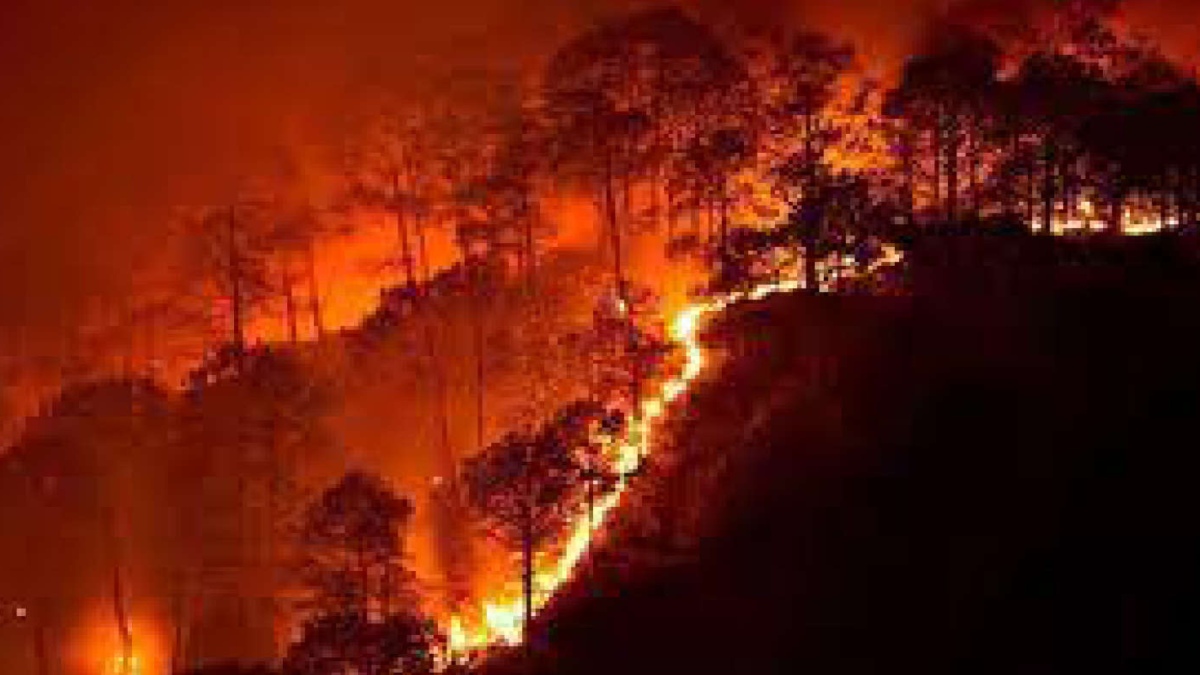
Since March, there have been more than a 1,000 major forest fires across the country. Last month, when the Jodibill Reserve Forest near the Similipal Biosphere Reserve in Odisha was ablaze, many other pristine forests and wildlife reserves in many other states in the country were also burning. Fire alerts have been continuously coming from Telangana, Madhya Pradesh, many Northeastern states and Uttarakhand. The peak forest fire season in the country began as usual in March with 3,308 incidents this year, as compared to 1,004 in the corresponding month in 2019. Two major causes which emerge are the failure of forest governance and of disaster governance. After every forest fire, debates are diverted towards assessment of the government’s capacity to douse forest fires but a demand for accountability from those who failed on preparedness gets muted. Only a few question the government’s intention as a causal factor for forest fires.
While I was writing this piece, I received a petition for support from the communities of the Sattal lakes and the forests in Kumaon. Despite the massive devastation that Uttaranchal has been facing due to vanishing forests and ongoing forest fires, it is bent upon invading the pristine biodiversity area and wreaking havoc through the construction of children’s parks, hotels, shops and parking spaces. Uttarakhand’s uncontrollable fire has already scarred more than 700 hectares and remains unstoppable. The government has admitted that in the current month alone a monetary loss of Rs 14,18,909 is estimated, but if the value of ecosystem services obtained from a rich forest biodiversity is also added to it, this loss may multiply manifold. Replying to a question in the Rajya Sabha, the Minister of State for Environment revealed that in 2019 the area affected by forest fires was a massive 93,273 hectares, suggesting an equally baffling figure for damage and losses.
Interestingly, forest fires are not even recognized as a natural disaster in the framework of National Disaster Management Authority (NDMA). Initially, in the 2009 National Policy on Disaster Management, only earthquakes, floods, wind, cyclones and landslides were recognised as disasters. Later, glacial lake outbursts and heatwaves have been added to the list. But the much needed recognition of forest fires as a disaster is shockingly still missing.
The Forest Protection Division of the Ministry had formulated a National Action Plan on Forest Fires in April 2018 and a report ‘Strengthening Forest Fire Management in India’ was also published. The Ministry also launched a faster and more robust version of Fire Alert System in January 2019 through the Forest Survey of India (FSI) Dehradun. In the meantime, the National Green Tribunal, unsuccessfully, directed the Ministry to constitute a National Monitoring Committee to monitor the National Action Plan on Forest Fires. NDMA’s failure to recognise forest fires as a natural disaster has prevented a synchronized preparedness exercise in accordance with the Sendai Framework for Disaster Risk Reduction. A previously constituted Standing Fire Advisory Committee of the NDMA had a highly deficient record of equipment, rescue vehicles and trained manpower which prevented any monitoring of funds allocated for fire prevention to state governments.
Forest fires have been the main reason for the loss of forest cover, and with no immediate afforestation, this land is occupied by encroachers making the rest of it still more vulnerable to fires. The Forest Survey of India in 2019 found more than 36% of forest cover in the country as severely vulnerable to fire.
Who could be behind forest fires? There is enough evidence in the history of forest fires about an unholy nexus of miners, the timber mafia, poachers and their representatives in the government who surreptitiously get forest land released for non-forest purposes. The arrest of two men behind the recent Jodibill incident confirms the presence of criminals behind forest fires. A 2002 Down to Earth report had said that the Terai region’s timber smuggling is linked to the poaching of tigers, panthers, elephants, Himalayan black bear and musk deer to such an extent that more than 20-30 trucks get past through most check posts illegally. The forest departments can do nothing before these well armed and well connected mafia agents. Many forest guards are killed every year trying to save animals or timber from criminals. Only last month while a forest guard was shot dead by mafia goons in Dewas, three other forest guards suffered critical injuries in Panna Forest Reserve of Madhya Pradesh after being attacked with axes, choppers and spades. A forest guard is a Group C, non-gazetted, non-ministerial post with a starting salary of Rs 5,200 and is given neither weapons nor life-saving boots, appropriate uniform and protective headgear. They are always overpowered and outnumbered once caught patrolling inside the criminal-occupied forest areas.
Fires push endemic species to extinction as they have location-based lives. While the administration gets busy dousing the fire, traffickers drive off with their wanted reptiles and exotic mammals. Tigers and elephants are dedicated sentinels who guard these forests against illegal human trespassing and lose their lives like the forest guards. Many species of wild cats such as panthers, leopards, tigers and cheetahs have already become extinct due to fires and the subsequent loss of habitat. Many historians and conservationists such as Mahesh Rangarajan have recorded how thousands of tigers had been shot down in the years prior to Independence to vacate forest land for saleable property by the royals. Documentaries on elephants by filmmakers like Mike Pandey and Sangita Iyer highlight cruelties perpetrated by human beings and the diminishing impact of the law on protecting forests. A recently published report by the Global Forest Watch (GFW) has brought out shocking facts about India’s forests. In just one year of 2019-20, India has lost nearly 38.5 thousand hectares or 14% of tropical forest. GFW is an initiative of the World Resources Institute with an open source web application to monitor global forests. It recorded the deadliest forest loss in Mizoram (47.2% loss) followed by Manipur, Assam, Meghalaya and Nagaland, which when put together lost more than 52% of all tree cover in India in 2019-20. Our ‘Look East Policy’ is becoming a ‘Fire East Policy’.
Diversion of forest lands for non-forest use was made difficult by the Forest (Conservation) Act, 1980 (FCA 1980). Subsequently, the rate of diversion of forest land within a decade came down from 1.43 lakh ha to around 15,000 ha per annum. Many subsequent amendments to this restraining Act and, in supersession of the Forest (Conservation) Rules, 1981, many changes were brought in between 2014 and 2017. Most of these changes were not even displayed on the MOEFCC website which is considered quite mandatory for modern governance. The Web Measurement Index (WMI) reflecting upon the government’s intention of what it wants to hide or wishes to display reveals how interested the government is in protecting forests.
The changes to the Act further diluted Environment Impact Assessment procedures and eliminated any scope for assessing wildlife before granting clearances to projects on forest lands. Many forest animals who guarded their sacrosanct forest entry points, like the nilgais and monkeys were declared vermin in 2014-15 by short-sighted policies of the MOEFCC and instead of giving them a green cover they were eliminated within weeks in a brutal bloodshed unleashed upon them and abetted by the Ministry. There is also suspected data fuzzing on forest diversions. The Union Minister of Environment Prakash Javadekar in his 20 March 2020 statement in the Parliament divulges a figure of 3,616 projects involving 69,414.32 ha of diversion of forest land since 2014. But the MoEFCC’s e-Green website mentions a much higher diversion, a total of 72,685 ha of forest land. This e-Green website is a product of a Supreme Court directive to the Ministry for effective monitoring of the compensatory afforestation in the country through an authority named “Compensatory Afforestation Management and Planning Authority (CAMPA)”. So if two figures with an error of almost 3000 ha are available simultaneously on two government websites, is there yet another figure to which citizens have limited or no access?
Huge forest lands which have sketchy forest cover and immense vulnerability to fire await afforestation through CAMPA. This Division within the MoEFCC was constituted in 2009 by the Supreme Court order after a writ petition involving TN Godavarman Thirumulpad vs. Union of India & Ors. The Compensatory Afforestation Fund Act, 2016 further provided for the establishment of funds under the public accounts of India and of each state to credit the monies received from the user agencies towards compensatory afforestation recovered under the FCA1980. It’s laughable to accept that compensatory afforestation is actually possible despite the Court orders. Where is the land for it? If land was available then there wouldn’t have been any need for encroaching into forest land. Consequently, CAMPA became a dragging and rejected division as the minutes of its seven crucial meetings reveal. In fact the first four meetings between 2009 and 2012 were so casual that the minutes neither had the Chairman’s signature (who is the Union Minister for MoEF) nor his name. Later meetings had both but no decisions were ever taken on direct forest management. A simple demand of the DG of FSI for much needed High Resolution Satellite Imagery like the Cartosat-1 and Ikonos for multisectoral and panchromatic imagery which could have increased fire detection capacity of forest personnel was dragged from the 5th to the 7th CAMPA Advisory Gp. meetings of 2015, after which no record of these meetings are displayed on its website which was last updated in November 2019.
Another scuttling of fire prevention efforts occurred when the government rejected every move to consolidate community network, awareness and fire fighting training proposals such as that from the Barefoot College which were brought to its meetings for approval. India’s forest story is saddening with only 3.02% of real dense forest in a forest cover of merely 21.67%. Sustainable and healthy human life needs at least 30% of forest cover but most of the forests we are left with are moderately covered or open forests. Appallingly, it appears that the MoEFCC engages more in the diversion of forest land than in forest fire prevention.
Is there a possibility that we can still blame climate change for forest fires in the first place? India’s forests are no more carbon sinks but carbon emission areas as one fifth of the 70.82 mha of forest land goes up in flames every year. The carbon emission to the atmosphere from these fires would be much higher than the Californian fire estimation of 91 metric ton released from a forest fire area of only 1.4 mha. In this background, the tall claim of the Environment Minister made in 2017 that India’s 1.56 metric tonnes of emissions in 2010 could be attributed to a nature-friendly Indian lifestyle needs revision and introspection unless we wish to maintain a fake global image of a benign Indian.
The writer is former Professor of Law & Governance, JNU, and president of Asia-Pacific Disaster Research Group (NDRG). The views expressed are personal.















